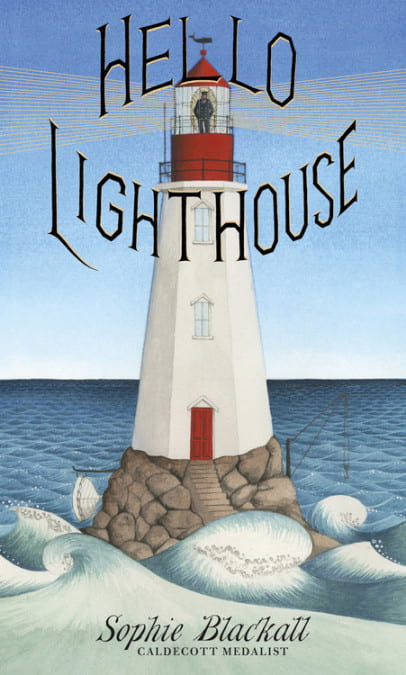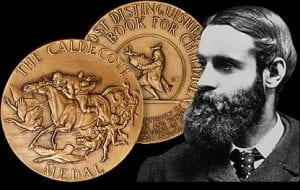
For this activity I chose to write a book review about a picture book which had received a young people’s book award. I achieved this by selecting a book, reading the book and taking notes on general observations along the way. This included the books appearance as well as the story being told. For this book review I chose the 2019 Caldecott medal winner, Hello Lighthouse, by Sophie Blackall.
Named after nineteenth-century illustrator Randolph Caldecott, this annual award is presented to an artist associated with an American children’s picture book. The award was created in 1938 after it was established that while authors were honoured with the Newbery Medal, illustrators were not receiving appropriate acknowledgment for their contribution to picture books (Association for Library Service to Children [ALSC], 2021b). The Caldecott Medal is now presented at the American Library Association’s annual conference alongside the Newbery Medal. Previous winners of the Caldecott Medal include Where the Wild Things Are, by Maurice Sendak; The Polar Express, by Chris Van Allsburg; and Owl Moon, illustrated by John Schoenherr and written by Jane Yolen (ALSC, 2021a). This is a prestigious award for any children’s illustrator and a positive acknowledgement to the importance of illustrations in picture books.
Illustrations play a critical role in children’s picture books because many books contain illustrations alone and others strongly depend upon them. The illustrations extend upon the text by revealing further valuable information and enhancing a child’s imagination. Alternatively, Aggleton (2017) found that the illustrations did not impact children’s interpretation of a story. Branzila (2018) disagrees and strongly believes that illustrations in children’s books are intrinsically linked with the text and provide great reader benefits. Furthermore, Martinez, Stier and Falcon (2016, p. 239) suggest that illustrations also provide a visual and verbal connection which provide “important clues” about the story being told (e.g., location, characters). In support of this, Aggleton (2017) does identify some limitations in her research (study was conducted with strong readers only) and suggests that illustrations could be a driving motivation for reluctant readers. Sands (2019) agrees that illustrations can be used to extend upon the text and to entice reluctant readers. Irrespective of differing opinions, it can be determined that illustrators are deserving to receive acknowledgement of their work and this is being successfully achieved through the Caldecott Award.
This activity was a good learning experience because it compelled me to take a more in-depth notice of all aspects of the book. Consideration was made for the observations I make when selecting a picture book but also what may appeal to a child. It also highlighted the importance of illustrations and the role they play in supporting the text in the telling of the story. This knowledge will be useful when making book suggestions to patrons and when considering which books to select for Storytime sessions. I had not previously heard of the Caldecott Medal and realised that I am not overly familiar with many other book awards. I will endeavour to do further research to discover more book awards for different genres. This is important because often these are the books that are most sought after and are great to use as suggestions for patrons.
References
Aggleton, J. (2017). “What is the use of a book without pictures?” an exploration of the impact of illustrations on reading experience in a monster calls. Children’s Literature in Education, 48, 230-244. https://link-springer-com.ezproxy.csu.edu.au/article/10.1007/s10583-016-9279-1
Association for Library Service to Children. (2021a). Caldecott medal honors to present. American Library Association. http://www.ala.org/alsc/sites/ala.org.alsc/files/content/awardsgrants/bookmedia/caldecottmedal/caldecott-medal-honors-to-presentNEW.pdf
Association for Library Service to Children. (2021b). Randolph Caldecott Medal. American Library Association http://www.ala.org/alsc/awardsgrants/bookmedia/caldecott
Blackall, S. (2019). Hello lighthouse (S. Blackall, Illus.). Orchard Books.
Branzila, I. C. (2018). Picture books and illustrations in the Anglo-Saxon literature for the young. Philologica Jassyensia, 14(1), 165-171. https://www-proquest-com.ezproxy.csu.edu.au/docview/2097439312/fulltextPDF/713F8395B0F14D4CPQ/1?accountid=10344
Caldecott Medal and Randolph Caldecott. (2018). [Image]. University of Findlay’s Mazza Museum. https://www.mazzamuseum.org/caldecott-read-in-held/
Martinez, M., Stier, C., & Falcon, L. (2016). Judging books by its cover: an investigation of peritextual features in Caldecott Award books. Children’s Literature in Education, 47, 225-241. https://link-springer-com.ezproxy.csu.edu.au/article/10.1007/s10583-016-9272-8
Sands, L. (2019). Reading rocks! using illustration to encourage a love of reading. The School Librarian, 67(2), 69-70. https://ezproxy.csu.edu.au/login?url=https://www-proquest-com.ezproxy.csu.edu.au/scholarly-journals/reading-rocks-using-illustration-encourage-love/docview/2398186728/se-2?accountid=10344
